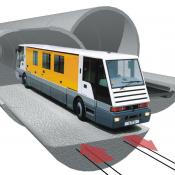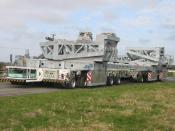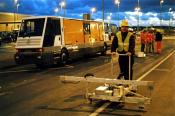![]()
Track guidance systems allow vehicles without drivers to move along a current carrying conductor.
In contrast to the optical track guidance (e. g. dark line on a light coloured surface) the inductive method has the advantage that it is not sensitive to oil, dirt, tyre abrasion etc. Thus their use has gained acceptance in harbours and industrial plants. Reference frequency and current as well as lateral separation and height from guide conductor can be selected from a large scope of variants.
Some sensors also have a microcomputer, which substantially increases output performance and the comfort while using the device. This track guidance system is mostly used for the operation of in-company transport. Increasingly buses (public transport), special vehicles (tunnel) and cars (for test collisions) are also being fitted with inductive track guidance systems.
An inductive system typically consists of a frequency generator, a steering antenna and the guide wire in the ground (ground installation). The ground equipment has to be installed by the customer (see below).
In order to calculate the inductance of a wire loop and to find matching Götting generators you can use our Inductance Calculator.
You can find an info sheet about the design of the ground installation in the downloads below.
Application Examples and Downloads
- automated wheel loader
- guide wire agv (car assembly)
- AGV with inductive track guidance
- People Mover in the Eurotunnel
- Heavy duty AGV transporting aircraft wings
- Guide wire measurement in the Eurotunnel
| Attachment | Filesize – | Uploaded |
|---|---|---|
| 92.84 KB | 19.01.2015 |







